
“Between Eternity and the thirty-one persons aboard, a one-inch envelope of metal and four man-made engines…”
Director: Fred F. Sears
Starring: Gary Merrill, Nancy Davis, Roger Smith, Sheridan Comerate, Jewell Lain, Bek Nelson, Irene Hervey, Lewis Martin, Richard Keith, Hal Torey, Celia Lovsky, Rodolfo Hoyos Jr, John McNamara, Dayle Rodney, Robin Warga, Kim Charney, Ronald Green, Robert Whiteside
Screenplay: Fred Freiburger
Synopsis: As he struggles to hold his crippled plane steady, and contemplates his responsibility for his passengers and crew, Captain Steve Williams (Gary Merrill) thinks back over the events that led up to this critical moment… Arriving home early at their home in Lisbon, American pilot Steve Williams greets his wife, Helen (Nancy Davis), and their son, Barrie (Kim Charney), who have been clothes shopping in preparation for Barrie’s first important party. However, the reunion turns sour when Williams presents Barrie with a horn for his bike as a gift: obviously uncomfortable, the boy tells his father that his bike has been stolen but refuses to give details. When they are alone, Helen tells her husband that after having an accident on the bike, Barrie was scared to ride it again and gave it away. Williams reacts with outrage, dismissing Helen’s explanation that Barrie is afraid to admit failure to him; and as punishment for his lie, he forbids Barrie to attend the party. An exasperated Helen criticises Williams for his lack of understanding and intolerance of mistakes. Williams refuses to retract his punishment, however, and he and Helen are still at odds when she drops him off at the airport for his flight between Lisbon and New York. Inside the airport, flight engineer Howard Whitney (Sheridan Comerate) reacts with dismay when he learns he will be flying with Williams, who has a reputation as a martinet. Sure enough, as soon as he arrives, Williams begins grilling his engineer over a maintenance report suggesting trouble with one of their plane’s engines. Whitney tells him that both he and the ground crew have checked the engine and passed it, but Williams insists on a third inspection. As he crosses the terminal, Williams is hailed by stewardess Nancy Arthur (Bek Nelson), who tells him that two of their passengers, Carlos Ortega (Rodolfo Hoyos Jr) and his elderly mother (Celia Lovsky) are in difficulties over the latter’s misplacement of her visa; Williams excuses himself on the grounds that it is a matter for immigration. In the airport lounge, executive Harrison White (Richard Keith) horrifies his colleague, Calvin Havelick (Hal Torey) with his ruthless plan to drive a competitor out of business; Havelick responds by downing a large drink… Outside the terminal, young Teddy Burton (Robin Warga) accosts co-pilot John Smithback (Roger Smith) about his dog; Smithback reassures him that Wilbur’s crate will be in a hold just behind the lounge and that, if the conditions allow it, he should be able to visit. Teddy is then called away by his father, Phil (John McNamara), and mother, Adele (Dayle Rodney), the latter of whom is carrying his baby brother. As the flight is called, a flustered Bernice Willouby (Irene Hervey) rushes to the counter, where a fellow-passenger, Maurice Stanley (Lewis Martin) courteously steps aside for her. With the passengers settled, Flight #627 takes off. Williams soon allows Whitney to take over for him; while Smithback tries to make time with stewardess Ann Thatcher (Jewell Lain). When the flight hits turbulence, making some of the passengers unwell, Ann returns to ask Williams if they cannot rise above the rough conditions, but he refuses to deviate from the flight-plan. However, the crew soon has something more urgent to think about, as one of the engines begins to make a disturbing noise…
Comments: During the second half of the 1950s, there was a rush of plane-related disaster movies and dramas, most of them inspired by one of two real-life tragedies: the metal fatigue-related Comet crashes, which occurred across 1952-1953; and the 1955 bombing of United Airlines Flight #629 over Colorado.
But there were also a few exceptions. The first disaster movie of the modern era, The High And The Mighty, was based upon the novel of the same name by former pilot, Ernest K. Gann—who in turn based his story on an experience of his own, when the plane he was flying between Honolulu and Burbank developed engine trouble.
Meanwhile, 1958’s Crash Landing was based upon a different real-life incident, the ditching of Pan Am Flight #6 during the final leg of its round-the-world flight.
There are some curious concurrences between The High And The Mighty and Crash Landing, and some significant differences, too. Both films revolve around an engine-trouble-related crisis which gives the crew time to second-guess themselves, and the passengers plenty of opportunity to sit and think about their situation and their lives.
Meanwhile, when Ernest Gann wrote his novel, he changed the destination of his endangered flight to San Francisco, a detail carried over into the film adaptation; while the ditching of Flight #6 actually occurred between Honolulu and San Francisco. However, for reasons that aren’t clear, when Crash Landing was produced, the flight-plan was changed to Lisbon-New York; with engine trouble developing – surprise! – just after the plane crosses the point of no return.
Otherwise— The High And the Mighty is a big-budget, ensemble-cast, widescreen and “WarnerColor” film starring John Wayne and directed by William Wellman, with a running-time of over two hours; while Crash Landing is a low-budget, black-and-white programmer starring Gary Merrill that runs only 77 minutes and was produced by Sam Katzman and directed by Fred F. Sears—who seems, sadly, to have literally worked himself to death at the age of only forty-four: this one was of five films by the director to be released in 1958, a year after he died.
(Sears is of course best known in these parts for his genre movies, including the magnificently terrible The Giant Claw.)

But there is one point at which these two films touch that I found absolutely fascinating. In The High And The Mighty, the pilots must make a choice between pushing on to San Francisco, despite their dangerous lack of fuel, or ditching: John Wayne’s choice to push on is presented as the self-evidently correct one; while Robert Stack’s preference for ditching is explicitly presented as an act of cowardice.
Yet in Crash Landing, made only four years later, the choice to ditch is presented as the first and only choice, the safest and wisest thing to be done under the circumstances.
So what happened?
Well, the short answer is that Pan Am Flight #6 happened: it was the first incident of ditching in aviation history in which there were no fatalities. Most prior incidents had had disastrous consequences, including the ditching of another Pan Am flight only the year before, during a flight between Portland and Honolulu.
(OH MY GOD WHAT IS IT WITH HONOLULU!?)
In that case, the tail-section broke off upon impact, and four of the nineteen passengers were killed.
But as the saying goes in aviation, every accident makes flying safer; and it was unquestionably the grim lessons learned from its predecessor that allowed the successful ditching of Flight #6: the passengers were moved to the front of the plane; all loose objects were secured; the plane was kept in the air as long as possible to burn up the remaining fuel, both to lighten it to assist with flotation and to lessen the danger of a fire; and the pilot waited until daylight until attempting the ditch. Once again the tail-section broke off upon impact but, in this case, no passengers were injured as a consequence. The plane floated long enough for the passengers and crew to be evacuated into inflatable rafts; from these they were rescued by the USCGC Pontchartrain, which had been alerted to the developing crisis and stayed in the vicinity of the plane as it prepared to ditch.

The crew-members later received citations for their handling of the situation, with Captain Richard Ogg becoming the first recipient of the Civilian Airmanship Award.
So that’s the good news. The bad news is that when I said there were no casualties, I meant no human casualties: Flight #6 was also carrying forty-four cases of live canaries, which were left behind when the plane was evacuated.
I did NOT need to know that…
Produced a year later, although not released until 1958, Crash Landing follows the outline of the Flight #6 story in most respects, including the technical details of what went wrong and how the unfolding crisis was handled. The exceptions are that (as mentioned) the flight-plan was altered, and the identity of the following ship was changed from a Coast Guard vessel to an American destroyer.
But of course, rather than merely dealing with the ditching, Crash Landing also expands its story to deal with the personal issues of the passengers and crew onboard its plane—therefore transforming itself from a drama into a disaster movie.
But in making this choice, it could be argued that Fred Freiberger (for whom this was a rare film screenplay in the midst of a remarkable career writing for television) did not go far enough. Instead of the enjoyable histrionics that enliven The High And The Mighty, and despite the poster that promises, This is the moment when 32 lives are laid bare!!!, Crash Landing is pretty weak tea, with the dull domestic issues of the Williams family setting the tone for everything else that follows.
Crash Landing is told in halves, with the film opening in the cockpit just before the crisis begins to evolve. The flight itself, its passenger manifest and its crew are introduced via a pragmatic voiceover—the voice of Fred Sears. His speech concludes with the line quoted above…and immediately, one of the engines begins to malfunction, with flames extruding behind the propeller.

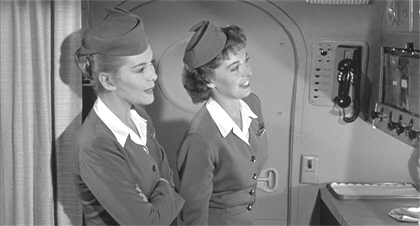
The crew is unable to fix the problem, but there is no sense of alarm: it is agreed that they can make it to New York on three engines, and there’s plenty of fuel.
And as soon as they’ve exchanged those comforting thoughts, a second engine malfunctions…
Williams immediately snaps at his engineer, waving aside his insistence that he did check the engines and insisting that, “A properly checked engine doesn’t fail!” He then gets onto the PA, to warn the passengers that they may have to ditch, but adds that the crew is properly trained and everything is under control.
Out in the cabin, the situation has its different effects: people are scared, but mostly calm. Mr Ortega comforts his elderly mother, while Phil Burton reassures his wife and young son. A businessman, Harrison White, mutters that this can’t happen now; while his companion, Calvin Havelick, makes a dive for the flask in his briefcase…
Then it’s voiceover time in the cockpit again, with the audience listening in as Steve Williams wonders how this situation could possibly have come about; whose fault it could be, if anyone’s; even if – gasp! – it could possibly be his fault! This last thought gives him a wry moment: he reflects that, in that case, Helen would be proved right; that she, “Would win, and yet lose…”
Yeah. Because it sure would be a loss not to have Little Miss Mary Sunshine around the house.
From here Crash Landing reverts to the various pre-flight incidents, in particular the unhappy situation in the Williams household, where we discover Williams himself to be a sort of tin-pot Great Santini, far more adept at discipline than understanding. Williams’ wife, Helen, criticises him for his rigidity and intolerance of error, pointing out that Barrie lied to him because he’s too scared to admit any kind of failure to his father. Williams is unmoved, and the three are still at odds when he must depart for his flight from Lisbon to New York.

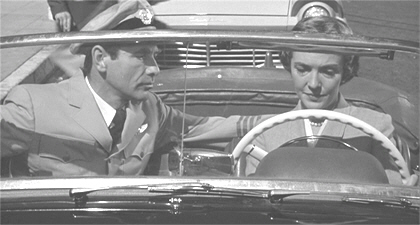
Although she received second billing, Nancy Davis really only has a supporting role in Crash Landing: apart from these scenes, we get one quick glimpse of her as the crisis is unfolding, and she makes one more brief appearance right at the end. This was actually Davis’s last theatrical film, although she continued to work in television until 1962.
At the airport, we are soon made aware that Williams’ colleagues have the same issues with him as his family. Everyone agrees that he is a first-class pilot, but nevertheless dread flying with him because of his hard-nosed, humourless attitude and tendency to expect the worst of the people around him. And before too long, the viewer has had the opportunity to draw another conclusions about Williams: that the man is just plain rude.
And then we begin to be introduced to the passengers. The more minor ones include an orthodox priest in full regalia; two “showgirls” (alleged), who we are nevertheless assured are both respectably engaged; two young military men; and an elderly couple, the Wheatons. We spend more time with Mr Ortega and his mother, the latter scared of flying but determined to know her six grandchildren in America before she dies; brash, self-made businessman Harrison White, and his colleague, Calvin Havelick, who has always skated on his charm and connections, and drinks a lot more than he should; and above all, sad career-woman / spinster Bernice Willouby and lonely widower Maurice Stanley, who find each other over the course of the crisis.
These last two were well-received by the critics at the time, but really, it’s even more than ordinarily Cliché City. We forgive them, however, because of a short coffee-related exchange of dialogue between “Bernice and Maurice” that (we realise with glee) was the inspiration for the two coffee-drinking kids in Flying High!…though alas, Miss Willouby does not go on to compare her black coffee to anything else.
Otherwise, the most important passengers are the happy Burton family, which includes – ulp! – an infant-in-arms and – ulp!! – a dog in the cargo hold. We first meet them when Teddy, having broken away from his parents, is hanging over a fence watching the luggage being loaded, and is reassured about Wilbur the dog by co-pilot John Smithback.


At the same time we discover that, as if a dog in the cargo hold isn’t bad enough, Wilbur is travelling in company with a dozen small wood-and-wire cages containing – ULP!!!! – budgerigars, presumably standing in for Flight #6’s doomed canaries.
{…*whimper*…}
Meanwhile, Smithback is pursuing stewardess Ann Thatcher, who has learned the lessons of her naval-wife sister and wants nothing to do with pilots—she thinks.
All this is standard stuff, of course; but as the film progresses we realise that all of it exists simply to make Steve Williams see the error of his ways. So the people on the plane either make mistakes that put Barrie’s transgressions in their proper context (mostly Harrison White); or they learn from their mistakes and become better people (mostly Calvin Havelick); or they’re nice to each other just for the heck of it (nearly everyone else). Or – if they’re the Burtons – they give Williams an object lesson in affectionate and friendly father-son relations.
Anyway— The first difficulty encountered is bad turbulence, which is making some of the passengers sick. Ann enters the cockpit to ask if they mightn’t rise to a higher altitude to avoid it, but Williams won’t even consider requesting a change to their flight-plan. (It’s all right for him, of course: he’s not the one handing out barf-bags.) Ann then requests that a member of the crew do a walk-through, to reassure everyone. Smithback volunteers, but Williams agrees to do it, handing his controls over to Whitney in his absence.
As the cockpit door closes behind him, the others exchange surprised grins:
Smithback: “How’s he going to tell a guy not to worry while biting him on the seat of his pants?”
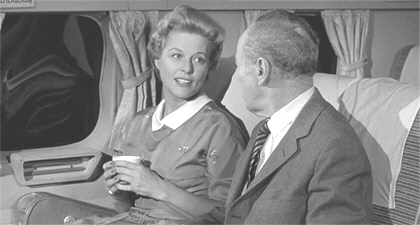
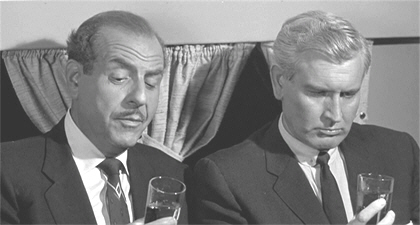
On his journey down the aisle, Williams unbends far enough to tell Teddy Burton he can visit Wilbur once the plane stops pitching. He then hangs around for a time, casting envious eyes on Phil Burton’s easy back-and-forth with Teddy.
Less positive is Williams’ encounter with a drunken Calvin Havelick, who embarrassingly denounces himself and his previous attitude to life, but also calls out Harrison White for his brutal attitude to business and his efforts to blackmail him, Havelick, into supporting his latest scheme.
Two things then happen almost simultaneously: the passengers spot an American destroyer out on manoeuvres below them on the ocean; and the plane reaches the point at which it is assigned to climb from 13,000 to 21,000 feet.
Almost immediately there is a hint of trouble: engines #3 and #4 seem to be running correctly, but Williams feels that they don’t sound quite right. There is no clear sign that anything is wrong, however, and they continue on. Williams swaps with Whitney again, and goes to check in with navigator Jed Sutton, who reports they have just reached the point of no return…
Almost as soon as the plane has reached 21,000 feet, engine #4 begins to malfunction…
…and very belatedly – 42 minutes into a 77-minute film – Crash Landing pulls out of its flashback; somewhat confusingly for the viewer, it must be said, as the plane now has two malfunctioning engines instead of one. Engine #4 continues to misfire, while #1 dies altogether.
Williams radios the destroyer, warning that the plane may need assistance. The captain of the ship alerts his crew, and has them prepare for a potential rescue mission. Williams’ next move is to radio Lisbon with his plane’s situation, explaining that the excess fuel consumption needed to overcome the drag caused by the damaged engines makes it highly unlikely they can reach New York; and that in any event, they are struggling to maintain altitude. The airline officials leave the decision as to whether or not to ditch up to Williams.

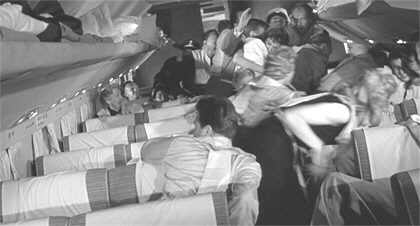
Williams responds by snapping and snarling at his crew—and, in response to Whitney’s indignant protest, revealing the war-time incident that made him such a hard-ass (you knew there’d be one, right?): that the one time he wasn’t, the one time he went without checking his crew’s actions for himself, one of the pilots under his command forgot his oxygen (!); he was forced to pull out of formation, which unbalanced the squadron and, long story short, thirty-three men dead.
(Which…doesn’t really explain why he’s such a dick in the other aspects of his life…)
Suddenly, the plane threatens to stall; but struggling together, the crew manages to bring it back under control. This makes up Williams’ mind, and he begins to prepare to ditch—radioing the destroyer for its course and speed data, so that they can intercept, and also for information about temperature and conditions. As it turns out, conditions are almost ideal—if there is such a thing—except for the darkness. The crew must choose between ditching immediately, without giving the passengers time to think about it, or waiting until daybreak: the light will allow for the plane to be correctly lined up with the surface of the water and so reduce the risk of hitting wing-first; but it also means more than two hours of flying, and the risk of growing panic…
Williams, with his low opinion of humanity, favours the first option, of course. Ann and Nancy have already given the emergency instructions, and Smithback has visited the cabin to answer questions and reassure the passengers (as well as finding a moment to, uh, “reassure” Ann in a more personal way); but now Williams goes back to emphasise what is needed from everyone. It is also at this point that he instructs Nancy to bring all the passengers forward.
(It’s still the 50s, and discretion is still the norm; but in one oblique moment, after a frightened Nancy confesses to Williams that this is her first professional crisis, we see her reaching for a paper bag!)
And it is not until this moment that Teddy Burton spares a thought for his unfortunate dog.


Really? Really!?
Williams gives Teddy a firm but gentle speech about responsibility and sacrifice. This is supposed to be a breakthrough moment for him, although some of us might be inclined to think that he just feels at home explaining to a child why his dog has to die. (At any rate, he does better than Mr Burton, whose first words are, literally, “When we get home we’ll get you another dog.”) Teddy accepts the situation, however mournfully, after Williams promises to take his cap back to Wilbur, so that he’ll know Teddy hasn’t forgotten him.
So it isn’t Teddy who panics, though I for one would have forgiven him if he had (not that I’m forgiving him for not panicking a lot earlier). Instead, the film makes an odd choice: it privileges spoiled blue-blood Calvin Havelick, who rises to the occasion, over self-made Harrison White—who morphs into Panicky Idiot #1, and almost precipitates a crisis when his own freak-out causes a number of the other passengers to—well, not to panic exactly, but to make exactly the sudden movements that Williams warned them against.
Sure enough, the plane lurches—the resulting weight imbalance causing it to tip even further. As Smithback fights with the controls, Williams barks orders at the passengers, forcing them back into their seats, and seatbelts.
Curiously, this incident has the opposite effect on Williams that we might have expected: he begins to contemplate waiting for daylight, and he invites opinions from his crew. They debate the pros and cons, the latter including the danger of one of the damaged engines tearing loose. This is the first time his colleagues have ever heard Williams sound uncertain about anything, and they can’t help raising their eyebrows. As the four agree to wait for daylight, Williams addresses his men by their first names; they respond by calling him “Skipper”.
Williams sends Smithback into the cabin again to report the change of plan. He also gives him Teddy’s cap, for Wilbur—and suggests, since the plane is low enough, that he open a window and let the budgies out…


(That’s a nice thought, but— Even supposing the poor little things survive the transfer to flight-speed, how far are we from land? Budgies can fly up to 250 km a day, but I’m not sure how far they can go without a rest. Hopefully these particularly birds are both tough enough, and smart enough to land on the destroyer…)
At last the sun rises, and the passengers are asked to prepare. At Nancy’s prompting, a reluctant Mrs Burton hands her baby over to the beefier of the two young military men, to be held during the crash landing.
Finally the moment comes. The plane lowers, skims, hits—once—and then again. For a time the plane is tossed about violently—and then it comes to a halt.
The emergency exits are thrown open and the inflatable rafts deployed. The passengers scramble out, climbing awkwardly into the rafts. As they push away from the floating plane, the launch from the destroyer arrives.
At last only the two pilots are left onboard. Smithback reports that the tail-section looks as if it might go, and Williams orders him off the plane; adding that he will stay to, “Make a last check.” It is several minutes before he reappears, and when he steps out onto the wing, he is carrying Wilbur…
(Yes, yes, okay; but may I just point out that if we had to have an infant in arms, there’s no reason why we shouldn’t have had a dog in arms too!?)
As a drama, Crash Landing is too realistic for its own good—taking such a matter-of-fact approach to its subject matter, it almost succeeds in making a plane-crash dull. The redemption of Steve Williams is insufficient as a plot-pivot; the character scenes, particularly those between Miss Willouby and Mr Stanley, and between White and Havelick, go on far too long; while the sensible behaviour of most of the passengers robs the film of both tension and agreeable exaggeration. In fact, it’s hard not to conclude that the Burton baby, Wilbur the dog and the unfortunate budgies were included chiefly to raise the emotional stakes. In which case, mission accomplished.
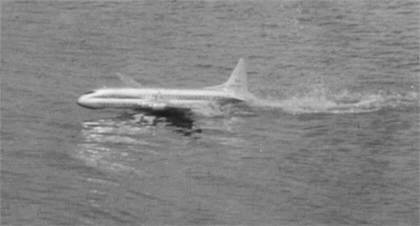
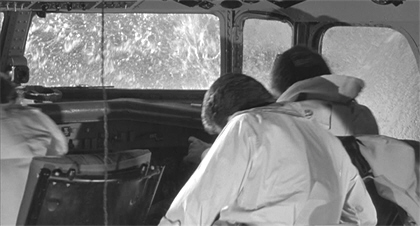
(I should mention that young Master Burton had his model in the single injury sustained during the ditching of Flight #6, an eighteen-month-old girl who was knocked unconscious. In the contemporary absence of carriers and/or restraints for small children, she too was held during the impact.)
The low budget also works against the success of the film, with Flight #627 rendered via some questionable model-work—which, moreover, uses the wrong kind of plane (it’s supposed to be a DC-7, but the model used is of a DC-6). During the rescue sequence at the end, careless set-ups and angles give away the fact that this footage was photographed in the safety of a swimming-pool—the edge of which can be seen in the background of some shots. Furthermore, the tiny cockpit may be technically correct, but the necessity for the flight-crew to climb over each other every time someone leaves – which is often – is terribly distracting. The set used for the cabin of the plane is more realistic, and also more interesting—inasmuch as it seems to be the same one used in Zero Hour!
Crash Landing gains a bit more importance, at least in the historical sense, if viewed as a disaster movie. It occupies an important slot in the evolution of the aeroplane sub-genre, being preceded by a film about engine trouble, one about a civilian landing a plane, and one about a traumatised war-veteran doing likewise; while it was followed by not one but two films about a bomb on a plane. It remains the only entry built around a ditching.
Another detail connected with this film is worth highlighting—more accidental importance if you like: it also represents a step in the evolution of the box-picture. In this Crash Landing followed the lead of The High And The Mighty, which presented its all-star cast that way; but this was the first of this sub-set of films to use the approach of shorthand character-sketches as a way of promoting a production: something which would become standard under the benign tyranny of Irwin Allen.
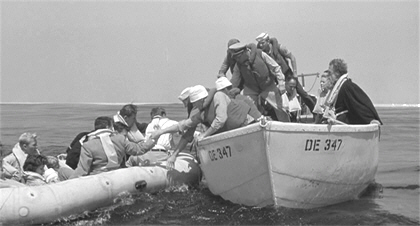

And there’s one more point I need to make about that poster. Consider again that tag-line: This is the moment when 32 lives are laid bare!!!
That is to say—the lives of 25 passengers—and of 6 crew-members—and of Wilbur the dog.
Yes, yes.
Okay…
.
Footnote: The crew of the USCGC Pontchartrain didn’t only assist with the rescue of passengers from the ditched Pan Am Flight #6: they filmed the entire episode. The footage was later released as a short documentary, and is available on YouTube. Still frames were also reproduced in magazine and newspaper coverage of the incident; while Crash Landing itself uses snippets of the film during its reproduction of the scene (which is why the picture quality suddenly drops).





So this is a rare exception to “crash it in the first ten minutes or don’t crash it at all”…
“Honolulu: A Surprisingly Long Way From Anywhere Else.” (And because it’s near the equator, Mercator-projection distortions make the distances look shorter than they really are.)
I first came across Fred Freiberger as “the man who ruined Space: 1999” – or from another perspective, the man who was brought in to save it and desperately tried to raise ratings in the second season the way he’d saved other shows (by adding more TV-grade action and sex), annoying the people who’d liked the first season and failing to gain enough new fans from elsewhere.
I wonder just how much of Williams’ behaviour would have been regarded at first by contemporary audiences as “that’s just the way a successful [white] man is entitled to behave”.
Ah, so he was a bad officer. That explains it all. (The officer’s job is not to do his men’s jobs for them, it’s to keep them in the state where they do their jobs for themselves.)
There haven’t been a lot of ditchings, full stop. Somehow I don’t see anyone making a film about KLM Flight 633 (crash a minute after takeoff; 2½ hours later, the navigator made it back to the airport and told them about it, because they hadn’t noticed). US1549 (“Miracle on the Hudson”) isn’t really cinematic enough, though they did try.
LikeLike
No, no—this doesn’t count as crashing; it’s a “lousy landing” film, like Zero Hour! and Terror In The Sky. (I’m not going to say Julie, because Doris only bounced the plane a little bit!)
Of course Honolulu was a common mid-ocean stop at the time. It was just putting that string of real and fictional incidents together and realising that every one of them was “Honolulu and—.” 😀
The man you call in when you want something “less intellectual”, what a job…
With Williams, other than his wife the people doing all the complaining are other white men, so I think we are supposed to see that he keeps too much of a choke-hold on everyone. The interesting thing is that the cause of the engine-failure is never made apparent—once the crisis stops being a faulty engine and starts being the need to ditch, there’s no suggestion (in-film or from Williams) that Whitney and the maintenance guys didn’t do their job properly, nor does Whitney react as if he thinks he’s to blame. And despite Williams riding Whitney at the airport and then in the cockpit, he doesn’t really seem to think so either. He was just being an ass.
Despite how matter-of-factly this film presents it, you certainly don’t want to ditch if you have another option: there have only been a very few non-fatal ditchings amongst a host of fatal ones. Although we should note that in several cases, the cause of death was post-ditch drowning, not the ditch itself.
The incident *I* want turned into a film was the 1952 ditching of a de Haviland Drover between New Guinea and Manus Island, where the pilot got knocked out and one of the passengers had to take over. Got it down, got the pilot out, and he, the pilot and the other passenger all survived. 🙂
LikeLiked by 1 person
Since we just had so much trouble with Southwest Airlines, should we expect another movie (or several) based on those incidents? For a change of pace, maybe they could make a movie about the ~200 flights Southwest has cancelled while they check for more engine problems (on the ground, much easier than in the air). That’s about 3% of their total flights. Surely some lives are being laid bare due to that.
Speaking on Honolulu, I was actually there back in the late 80’s on vacation when that plane had its top ripped off and the flight attendant sucked out. I didn’t pay much attention to it (on vacation, who needs news), but when I got back to work, the guys in the office had put the paper of the accident (with a lovely picture of the plane) on my desk, with the handwritten note, “Steve and Matt meet Dawn at the airport”. Nice to know I was missed.
LikeLike
I’m envisaging a Warhol-esque experimental movie in which a plane sits on the tarmac – and sits – and sits…and everyone experiences existential angst…
Oh my goodness! Yes, I’m familiar with that horrible incident. I was in Hawaii myself around that time but didn’t hear of it until some years later. (I wasn’t as obsessive on the subject then as I am now…)
I’m actually wrestling with myself right now, because I was going to copy over Jet Storm—but there having just been another such real-life incident, it felt tacky to do it just at the moment. But I don’t suppose the people affected would be visiting obscure websites and reading about disaster movies…
LikeLike
“I’m envisaging a Warhol-esque experimental movie in which a plane sits on the tarmac – and sits – and sits…and everyone experiences existential angst…”
During that post-9-11 period in which airliners filled with passengers were being left standing at the gate for eternities, I conceived of a throwback-to-the-’80s ‘wacky’ comedy titled “72 Hrs on the Tarmac” complete with the tagline “The disaster movie in which nothing breaks down, crashes or blows up! …WHO WILL SURVIVE?!?!”
(It’s not even my stupidest idea for a disaster movie; that would have been “George Orwell’s Airport 1984.”)
LikeLiked by 1 person
I’m bitterly disappointed that the box picture’s suggestion of a co-joined twin for The Daredevil Co-pilot doesn’t pan out. *That* would have been some drama (even when it was just them and The Icy-Nerved Pilot swapping seats in a confined cockpit)!
LikeLike
😀
Would have livened up all the swapping scenes, anyway. But honestly, there’s nothing remotely “daredevil” about this film, the co-pilot included; although he does perform the budgie-rescue, so of course he’s my hero…
LikeLiked by 1 person
It’s very suggestive of the way stewardesses were thought of and treated in the movies (and real life) of this era that everyone else in a box has an actual (stock) personality trait, but the stewardess is just “streamlined.”
LikeLike
Quoth Smithback: “She eats like a horse but looks like a gazelle.”
The advertising is more tacky than the film: it is one of the better things about these disaster movies that they never suggest that the stewardesses aren’t fully competent to handle an emergency. Usually they’ll have a private moment of meltdown (with or without comfort from a daredevil co-pilot), and then step up.
LikeLike
Oh, the Drovers that had prop failures. Yeah, an interesting one. Pilot’s contribution: be injured and knocked unconscious by prop fragments. Reward: George Medal. Passenger’s contribution: ditch the aircraft, get everyone into the life raft, summon help. Reward: Civil Commendation for Valuable Services.
While I can sort of see the “sensitivity” in not showing films when they’re closely related to recent tragedies, I think a review of an old film is well within the tolerances. (I note that there’s a film about school shootings in the US that’s ready to release but keeps getting postponed, and postponed…)
LikeLike
That’s why he needs a film made, dammit!
Yeah, it was more the awareness that when I first showed Jet Storm to my brother, neither of us having seen it, we both shrieked with shocked laughter at that moment. I know it’s not really related but it made me feel bad. (Plus the screenshots.)
LikeLike
Let me guess. George Orwell’s Airport 1984. Starring George Kennedy’s Big Brother.
LikeLike
DON’T TAUNT ME LIKE THAT!!!!
LikeLike
Yay! An air disaster movie just in time for flying season here in the Fraser Valley! Given your interest in aviation I’m guessing you’ve probably already read Macarthur Job’s books on some of the most important accidents and investigations but I thought I would mention them just in case you hadn’t heard of them. Volume 4 covers the early post WWII era. I ran across the series when I went to school in an unsuccessful attempt to become an aviation mechanic – never got a job (I graduated in the depths of the post 2001 slump and out of my class of 16 only one of us got work) but at least I get to use some of the knowledge gained in my role as maintenance director for my gliding club. The best thing about the experience was the school library. Aside from the utilitarian manuals etc. put to practical use there was also a massive quantity of aviation books that were just plain fun. I read my way through almost the entire library in the two years I was there. Quite often in class various well known accidents would be brought up, especially those related to maintenance errors of course and I found Job’s Air Disaster series covered the accidents and investigations very thoroughly. From the information in the account on Aloha Airlines flight 243 I figured that there was about a 90% chance I had flown on that very 737 on one of the two trips my family took to Hawaii in the 80’s!
LikeLike
Uhhh…you’e welcome? 🙂
I haven’t don’t much ‘outside’ reading, though I do watch Air Crash Investigation fairly regularly. Rather, I tend to research and read on a film-by-film basis, to see whether a particular incident may have been behind any particular production—as it was in this case. However the series you mention sounds very interesting and I may look into it sometime.
LikeLike
I’ve found pilots, especially the skilled and experienced ones spend a fair amount of time reading about accidents and incidents. One might think we would avoid thinking about all the mistakes we can make and all the things that can go wrong but it seems that doing so is vital for a long life in the air. Flying magazines have found that features about accident investigation or confessional stories (such as I Learned About Flying From That) are consistently the most read parts of the publication.
By the way, I’ve yet to meet a pilot from the lowest time private pilot to the highest time airline and military pilots who doesn’t love Airplane!/Flying High. I loved finding out the origins of that film on your site.
LikeLike
Learnings from accident investigation are a fundamental aspect of pilot training. The whole background to this film is a perfect illustration of how such information is used to improve safety and save lives.
Well, I should think not! As for me, I love tracing the evolution of things. 🙂
LikeLike